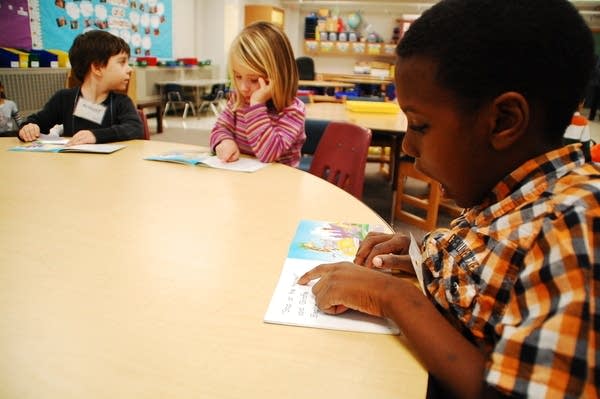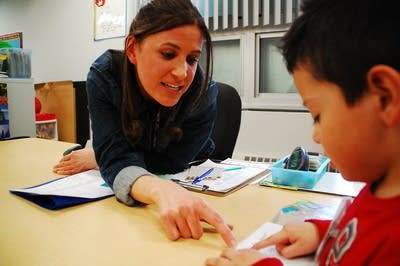Minn. kindergarten classrooms bursting at the seams

Many Minnesota school districts were surprised by an increase in kindergarten enrollment this fall, forcing some schools to add class sections and teachers.
Richfield was one of those districts. The school district's business manager, Michael Schwartz, was expecting about 385 kindergartners this fall. But instead the district enrolled 461.
"It was off substantially," Schwartz said.
To accommodate the 16 percent increase, Richfield hired a new kindergarten teacher, added another class and squeezed more students into kindergarten classrooms — as many as 28 per class in some schools.
Create a More Connected Minnesota
MPR News is your trusted resource for the news you need. With your support, MPR News brings accessible, courageous journalism and authentic conversation to everyone - free of paywalls and barriers. Your gift makes a difference.
Richfield isn't the only Minnesota district dealing with a fall bumper crop of kindergartners.
Anoka-Hennepin saw about 30 more kindergartners this year. Minneapolis Public Schools reports kindergarten enrollment is up more than 100 students from last fall. And St. Paul Public Schools officials say their enrollment is up by 206 compared to last year.
St. Paul Public Schools District Chief of Staff Michelle Walker said that required the hiring of a new kindergarten teacher, and the addition of class sections at six schools.

"Some schools have had to add additional classrooms, because they've added 20 more students than projected or 30 more students than projected," Walker said.
The increases aren't confined to the Twin Cities metro area.
"This year we had an increase of 54 kindergarten students over last year," said Lynn Kovash, superintendent of the Moorhead School District.
That forced Kovash to add three classes and three teachers, one in August, right before school started.
"We knew that we'd have more, we just didn't expect this many more students," Kovash said.
MORE RECRUITMENT, AND 'BABY BOOMLET-LETS'
So what's behind the increase in kindergartners?
For St. Paul and Minneapolis, part of the increase can be credited to more robust recruitment campaigns. The urban districts are working harder at winning over parents in the face of competition from charter and private schools.
And districts like Richfield say they've tempted more families in recent years with the addition of all-day kindergarten. Moorhead now offers an extended-day program.
But there's another reason for the increase: an old-fashioned baby boom.
Five and six years ago the number of births in the state exceeded 73,000 a year, the highest since 1964.
Minnesota State Demographer Susan Brower say today's kindergartners are the babies — of the babies — of the baby boomers.
"Demographers call the children of the boomers the boomlets," Brower said. "So maybe these grandchildren are the boomlet-lets."
The new baby boom fueled kindergarten enrollment spike isn't going to last.
State projections show births in the state fell off in 2008, at the beginning of the recession. So after spiking this year, kindergarten enrollment will fall off next year.
But not for long.
Minnesota's increasing population, especially among immigrants, means the state will see a rise in kindergarten enrollment starting again in 2016 and continuing into the foreseeable future.
AN IMPORTANT TASK FOR SCHOOLS
Projecting kindergarten enrollment is crucial as schools, and the state, plan for the future.
Consider this: The current rate of state funding is more than $5,000 per pupil. That means a projection short by only 1,000 students, could turn into a $5 million shortfall.
"The projections of student counts are very important in figuring out what our likely future state fund balances will be," said Bob Porter, school finance specialist at the state Department of Education. "The more students we have the more the state will have to pay."
Porter said the business of projecting kindergarten enrollment can be complicated and will only get more so in the future.
A sharp and unexpected increase in the birth rate would cause spikes in future kindergarten enrollment. A dip back into recession would do the opposite.
— Follow Tim Post on Twitter: http://www.twitter.com/timpostmpr
